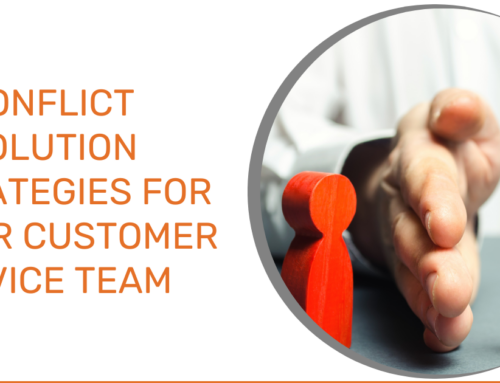Happy customers are the key to growing your franchise business, so we wouldn’t be surprised if you’re looking for ways to upgrade your service and support this year to create more raving fans. Improving customer service was one of our top business goals for 2023, and as promised, we’re diving into the topic today.
In this article, we’ll share seven steps you can follow to develop a customer service strategy that prioritizes your customers and ensures they get the best service every time they do business with your franchise. If you want to improve customer service in your franchise business, read on!
7 Steps to Develop a Customer Service Strategy
Great customer service doesn’t happen by chance. It results from intimately understanding your customers and strategically thinking about how to best serve them. Today we will guide you in seven steps to improve customer service by developing a thoughtful and detailed customer service strategy.
Step 1: Define Your Customer Service Goals
The first step is to identify what you want to achieve with your customer service strategy. Possible goals include reducing customer complaints, increasing customer retention, or improving customer satisfaction. It’s important to set clear and measurable goals that align with the overall objectives of your franchise business. Having these goals in mind will help you to focus on what truly matters and measure the effectiveness of your customer service strategy.
Also, remember that customer service goals may vary depending on the specific needs of your franchise and the type of customers you serve. For example, a franchise that caters to a younger and tech-savvy demographic may have different customer service goals than one that caters to an older and more traditional demographic. By understanding the unique needs of your customers and your franchise, you can set realistic and achievable goals. That brings us to Step 2…
Step 2: Understand Your Customers

Research to understand your customers’ demographics, needs, and pain points. Use this information to tailor your customer service strategy to them specifically. By understanding your customers, you can provide a better service that meets their needs, exceeds their expectations, and promotes loyalty. After all, acquiring a customer is five times more expensive than keeping an existing one.
There are many ways to conduct customer research, from surveys and focus groups to interviews and online research. Choose a method appropriate for your franchise and the type of customers you serve. For example, online research may be more effective than face-to-face interviews if your franchise caters to a younger crowd. And remember that customer research is not a one-and-done task. By regularly conducting customer research, you can keep up with the changing needs of your customers.
Step 3: Develop a Customer Service Plan

Using your goals and customer research, it’s time to create a plan to meet your customer service objectives. This plan should include specific tactics, timelines, and metrics for measuring success. A customer service plan is a roadmap that guides your customer service efforts and helps you to stay on track. It should be specific, measurable, achievable, relevant, and time-bound (SMART). We discussed this in our article on goal-setting frameworks, so check it out if you need a review.
In your plan, make sure to include:
- Tactics: The specific tactics you’ll use to achieve your customer service goals, including training your employees, implementing a customer feedback system, or creating a customer service policy.
- Timelines: The timeline for when the tactics will be implemented and when the goals will be achieved.
- Tracking: The metrics you’ll use to measure success, such as customer satisfaction rates, customer retention rates, and customer complaint rates.
Step 4: Train Your Employees
Once your customer service plan is established, you must provide thorough employee training. Training topics include:
- Why is customer service important?
- What are the company’s values?
- How can employees communicate these values effectively to customers?
- What is the overall customer service plan?
- What is each employee’s role in customer service?
- What are some examples of excellent customer service to model?
- How should employees handle difficult situations?
If phone communication is a regular part of an employee’s job, you’ll also want to train them to handle calls with customers. The FranchisePhones® VoIP phone system has excellent tools to help you with this. With call recording, you can share examples of great service to train new team members. Meanwhile, call coaching tools like ‘listen-in,’ ‘whisper,’ and ‘join’ can help managers train employees on calls in real time.
Your employees are the front line of your customer service strategy, and it is crucial that they are well-trained and equipped to handle customer interactions. Providing training will help develop skills essential to customer service, such as communication, problem-solving, and conflict resolution.
Step 5: Implement a Customer Feedback System

You may believe you have an excellent customer service strategy, but what do the customers think? By regularly collecting and analyzing customer feedback, you will see what is working well and identify areas for improvement. You can then use the information to make changes that will positively impact the customer experience.
There are many ways to collect customer feedback, from surveys and focus groups to online reviews and customer complaints. Check out this article on 9 ways to collect customer feedback for ideas. We wrote this one for auto dealerships specifically, but the ideas are relevant to franchises in any industry.
Step 6: Monitor and Measure Performance
When your customer service strategy is in full swing, you’ll want to regularly monitor how things are going (including analyzing the feedback you get from customers in Step 5). As you recall, in Step 3, we said that your plan should include a way to track performance. Using the metrics outlined in your plan, you can evaluate how your new customer service strategy works and adjust where needed.
Some of the metrics you may use to evaluate the success of your customer service strategy are:
- Customer satisfaction rates
- Customer retention rates
- Customer complaint rates
- Number of customer support tickets
- Resolution time
- Qualitative data such as customer reviews
Step 7: Review and Revise

A final step in developing a customer service strategy is to take the data you gathered in Step 6 and use it to make necessary changes. What does the data say? What are customers telling you? What is the experience of the employees? Based on what you learn, you can celebrate your wins and fine-tune what isn’t working as well.
A customer service strategy is not a one-time effort. It’s a continuous process that requires regular review and revision. The needs of your customers and your franchise may change over time. By regularly reviewing and revising your strategy, you can ensure that you exceed your customer’s expectations and keep them coming back for more.
Improve Customer Service and Grow Your Franchise!
Creating a customer service strategy for your franchise will help you deliver quality service in every customer interaction. Customers will feel valued and will enjoy a frictionless experience. Employees will understand what is expected and how to handle difficult situations. Meanwhile, you’ll be able to build long-term customer relationships and grow your franchise. Talk about a win-win-win for everyone involved!
Next, we will cover the last of the 6 business goals for 2023 – how to expand your thought leadership. Stay tuned!



